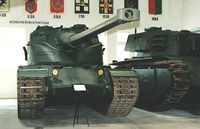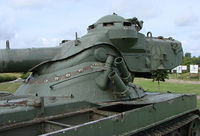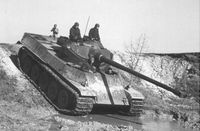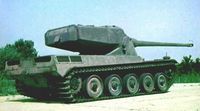AMX 50 B
| Revision as of 14:08, 12 January 2012 AMX 50 family history added | Revision as of 14:37, 12 January 2012 AMX 50B history added | |||
| Line 41: | Line 41: | |||
| {{History | {{History | |||
| |info= | |info= | |||
| + | ||||
| + | '''AMX 50B''' | |||
| + | [[image:AMX 50B, model with a cast hull and D type turret.jpg|thumb|200px|left|AMX 50B, model with a cast hull and Tourelle D type turret]] | |||
| + | When uparmored version of the AMX 50 120 reached the weight of 64.7 tonnes, serious problems were encountered with mechanical reliability despite considrable efforts put into reinforcing the suspension. In the period from 1956 to 1958, the tank was again resedigned and the weight was diminished to 57.8 metric tonnes. Cast hull was lowered, now under designation surbaissé ("AMX 50 Lowered"), and a new lighter (but also higher) turret was build, the Tourelle D (fourth type turret). Unfortunatly, problems with the maybach engine were never compleatly solved, and the power output never reached desired 1200 HP. Even the special design team from Germany, that came to France to assist AMX enginrres did not succeed to solve the engine problems. Maximum power output that was achived was limited to 1000 HP. Optimistically it was at that time projected that maximum speed could eventually be increased to 65 km/h. In the end in total only five complete AMX 50 prototypes would be constructed, including the final hull. | |||
| + | ||||
| ==AMX 50 Series development history== | ==AMX 50 Series development history== | |||
Revision as of 14:37, 12 January 2012
AMX 50B
| France | Heavy Tank | Tier X |
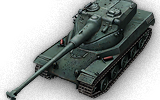
The AMX 50B is a French tier 10 heavy tank. It uses a 4 round drum autoloader.
- The AMX 50B marks the end of the French heavy tanks line.
Historical Info
When uparmored version of the AMX 50 120 reached the weight of 64.7 tonnes, serious problems were encountered with mechanical reliability despite considrable efforts put into reinforcing the suspension. In the period from 1956 to 1958, the tank was again resedigned and the weight was diminished to 57.8 metric tonnes. Cast hull was lowered, now under designation surbaissé ("AMX 50 Lowered"), and a new lighter (but also higher) turret was build, the Tourelle D (fourth type turret). Unfortunatly, problems with the maybach engine were never compleatly solved, and the power output never reached desired 1200 HP. Even the special design team from Germany, that came to France to assist AMX enginrres did not succeed to solve the engine problems. Maximum power output that was achived was limited to 1000 HP. Optimistically it was at that time projected that maximum speed could eventually be increased to 65 km/h. In the end in total only five complete AMX 50 prototypes would be constructed, including the final hull.
AMX 50 Series development history
Oscillating turret
Because there were five prototypes, it is not possible to give a description applying to all of them in detail. Weighing about fifty-five tons, the general AMX 50 project was the heaviest of a trio of French AFV designs of the postwar period (the others being the AMX-13 and the Panhard EBR) to feature an oscillating turret. The oscillating turret design, lacking a conventional gun-mantlet, is in two separate parts, with an upper and lower part connected by two hinge bolts or pivots, the gun being fixed within the upper section. The horizontal movement of the gun, traversing, is conventional, but the vertical movement, elevation, is achieved through the pivoting of the entire upper section with respect to the lower section. This method of elevation has two main advantages. Firstly it allows for a smaller turret volume, as no internal space is needed for the vertical movement of the gun breech. Secondly, it allows the use of a relatively simple auto-loader fed by multiround magazines, achieving a very high rate of fire for as long as the magazines were loaded, as the gun is also fixed with respect to the auto-loader located in the back of the upper turret, i.c. a protruding bustle. The automatic loading system worked satisfactorily when the calibre was 100 mm. After the larger 120 mm gun was introduced, reliability suffered, due to the increased weight of the rounds used. The oscillating turret was a very fashionable concept in the fifties, and also applied in some American projects, such as the T57 and T58. Only the French however, would produce operational systems.
German rolemodels
The hull was equipped with a torsion bar suspension designed to ensure a vehicle with good cross-country mobility. The hull and suspension recalled both the German Tiger and the Panther tanks which, having entered French service after the war, were well known and deliberately imitated. Especially the engine deck, the sprockets and the tracks are strongly reminiscent of the German design style. The nine overlapping tyred road wheels each side, were however much smaller. The French engineers had not been aware at first that the much admired German overlapping design had been motivated by a shortage of high quality rubber, necessitating large road wheels to lower tyre tension, which then were made overlapping to better distribute the load pressure. As France would have no trouble obtaining rubber of the desired quality, this feature was superfluous. Therefore the road wheels were made smaller, compared to the first design proposal, both to save weight and lower the profile of the tank, which was quite high due to a deep hull, a problem only changed in the fifth prototype. The track now had to be supported by five top rollers. The overlapping system as such was maintained in all prototypes; with smaller wheels it allowed for nine instead of the originally planned eight wheels, five forming the outer, four the inner row.
The hull sides were vertical, as in the case of the Tiger, while the front of the hull was in the first three prototypes evenly inclined at approximately 40 degrees from the horizontal, using sloped armour similar to that of the Panther and Tiger II. The corners between the glacis and the sides were truncated. The first two prototypes had a frontal protection level equivalent to about 120 mm "line-of-sight" thickness in the horizontal plane. The type was thus not particularly heavily armoured for its time. The weight increase with the third prototype was mainly caused by the larger turret and even in its fourth "uparmoured" form, doubling the frontal armour thickness, the AMX 50 was less well protected than its American and British competitors, themselves inferior in armour to the Soviet heavy tanks they had been created to fight. The fifth prototype used a lower cast hull, with a rounded frontal section for a better weight efficiency.
Above the massive hull, there was the oscillating turret, smaller, lighter and more compact than that of the Tiger; the sloped face of the upper part had a thickness of 85 mm. In the turret rear back there was the commander's cupola, well equipped with optical equipment. The turret had an optical rangefinder. The first two prototypes had twin 7.5 mm "Reibel" machine guns placed on top of the roof as an AA-weapon, a third was coaxial. In the first design proposal for a 120 mm version, the conventional turret had a high cupola armed with both a machine gun and a 20 mm MG 151 rapid fire cannon. However the third and fourth "120 mm" oscillating turret prototypes had a single 7.5 mm AA machine gun and a second 7.5 mm coaxial machine gun. For the production vehicles it was considered to install a coaxial 20 mm gun; lighter armoured targets could then be engaged without depleting the limited ammunition stock in the turret magazines. Despite the auto-loader, the crew was four: a second man was seated in the hull, functioning as radio-operator, but mainly needed to replenish the turret magazines from the hull ammunition stocks.
Jack of all trades wannabe
The AMX 50 as originally planned, would have been a medium, not a heavy, tank. It was supposed to be light, well armed and above all mobile. When the first two prototypes were made, low weight had already been sacrificed in favour of a high protection level, but it was still supposed to be a quite agile vehicle, in the 45 - 50 tonne weight class, with a hp/tonne ratio of over twenty. Expectations were high: as General Molinié afterwards ironically put it, it was hoped to create a tank with the protection of the Panther, the firepower of the Tiger, the mobility and abundance of the T-34, the reliability of the M4 Sherman and all that weighing less than the M26 Pershing. At that time France hoped to regain its position as a Great Power; rebuilding its armaments industry served this goal. To build an indigenous battle tank was however not merely a question of national prestige. Europe as a whole was trying to recover from the devastations caused by the war and to assert a modicum of independence towards the two superpowers, the USA and the USSR. To this end in 1948 the Treaty of Brussels was signed, which among other things was also a common defence agreement. The AMX 50, superior in armament and mobility to the existing American and British designs, was seen as the logical candidate for a common European tank, to equip the future armies of the Western European Union defence organisation. The prototypes were proudly displayed during the 1950 Bastille Day parade. Somewhat inconsequentially, it was hoped that the Americans would fund such a tank, as the financial position of the European states would not allow them to rearm.
That same year, the situation changed drastically due to the outbreak of the Korean War. Quickly the USA recommenced medium tank mass production, of the new M47 Patton. When this tank proved to be unsatisfactory, an even more advanced type was taken into production for the American forces, the M48 Patton; thousands of M47s were leased for free to the European allies, France included. The AMX 50 was suddenly made redundant as a medium tank, despite a "100 mm" prototype being sent in 1952 to the Aberdeen Proving Grounds for, successful, tests.Engine problems
To save the project, a new rôle was found in the Soviet heavy tank threat. In the early fifties, NATO tacticians were worried by the strong armour of the Soviet vehicles, that seemed to be immune to the guns of the existing Western types. In response Britain would develop the Conqueror and the USA the M103 heavy tank; abandoning the SOMUA SM, it was decided to let the AMX 50 evolve into a comparable type, even though other French heavy tank projects were in existence, such as the Char de 70 tonnes, a sort of "AMX 70". Already having a large chassis, the AMX 50 could in principle easily be adapted to carry the desired 120 mm gun — a derivation by the Atelier du Havre of the American gun, using the same ammunition — and had the advantage of a, on paper, very powerful engine. In practice there were many obstacles. Room could in fact only be found by increasing the height of the lower turret half, negating the advantages of the oscillating concept and creating a dangerous shot trap. The "uparmoured" version, with its deeper hull and flatter turret, was specially designed to counter this and make the vehicle immune in long range fire engagements, but further increased weight. In 1955 the AMX 50 was nevertheless very close to being ordered by the French government, that expected to produce the type for the reconstituted German Army also. A production was planned of a hundred for 1956. This decision had to be delayed however, due to the fact the engine problems had not been solved: reliability could only be assured if the output was limited to 850 hp, causing a mediocre hp/tonne ratio of about 13:1.
Delayes proved fatal
The delay proved fatal to the project. In the late fifties, swift advances in hollow charge technology led to an increased vulnerability for heavy tanks. Mobility thus gained a priority over protection and the very concept of a heavy tank became obsolete. As a result the project was changed again in intention, now trying to present itself as an agile main battle tank, with the same gun as the Conqueror but much lighter and more powerful. This failed as it was much too large and expensive; oscillating turrets also became unpopular as they were inherently difficult to protect against nuclear and chemical contamination. The engine problems with the Maybach were never overcome and lowering the hull to save weight, as was done for the final prototype, made it impossible to install a larger engine. Recognizing that the problem of combining excellent mobility with heavy armour was for the time being irresolvable, the AMX 50 project was terminated; the priority given to mobility demanded a new design concept, leading to the AMX 30, the lightest MBT of its time. Only in the early eighties would France again attempt to combine heavy armour and armament in its tank designs, beginning with the later AMX 32 prototypes. The AMX 50 would not be a complete waste of time and effort however, as much technological knowledge had been gained from which the AMX 30 would profit. In the Musée des Blindés at Saumur an AMX 50 is shown, a combination of the last cast hull and the Tourelle D.
